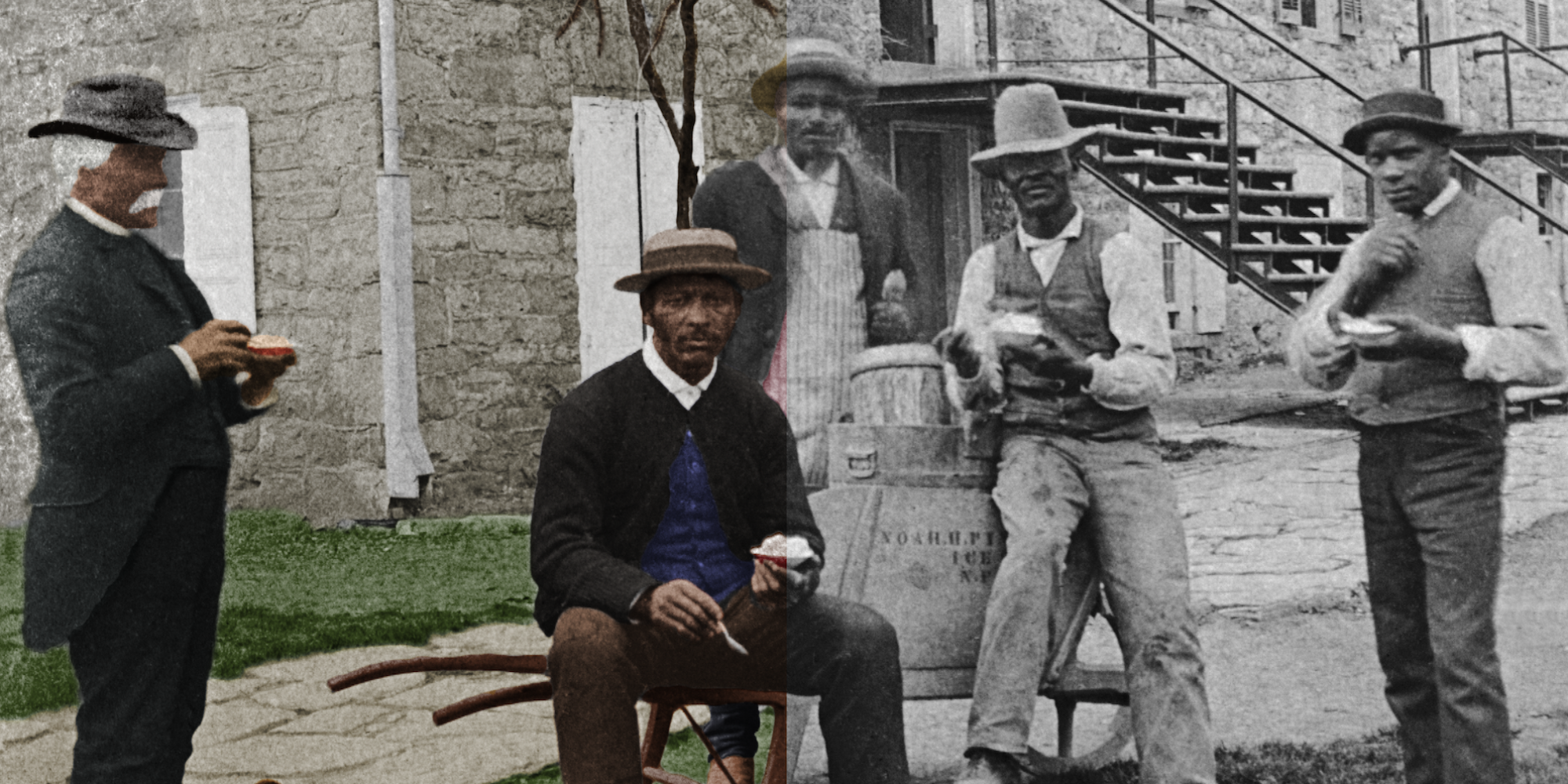Dickinson course sites
- History 311, American Slavery, Prof. Pinsker
- Africana Studies, Social Justice in the African American Imagination, Prof. Johnson
Colleges & Universities Studying Slavery
There are simply far too many web resources on the subject of slavery and academia to include here in their entirety, but this section highlights a range of introductory articles or projects that can help demonstrate some emerging trends and best practices.
- Jennifer Schuessler, “Confronting Academia’s Ties to Slavery,” New York Times, March 5, 2017
- Universities Studying Slavery consortium (includes more than three dozen higher ed institutions in US and UK)
- Brown University: Steering Committee on Slavery & Justice (2007)
- Columbia University: Columbia & Slavery (2017)
- Georgetown University: Slavery Archive (2017)
- Harvard University: Harvard and Slavery (2011)
- Princeton University: Princeton & Slavery (2018)
- University of Alabama: Hilary Green’s Hallowed Ground site (2018)
- University of Virginia: President’s Commission Report (2018)
General Reading
Again, the literature on slavery is vast, far too vast to summarize here in any kind of effective fashion. However, this section features some of the best recent scholarship, including several readable books for the modern classroom that have also been enhanced with multi-media teaching tools (such as custom-made Google maps) from the House Divided Project.
- David Brion Davis, Inhuman Bondage: The Rise and Fall of Slavery in the New World (2006) with map
- Eric Foner, Gateway to Freedom: The Hidden History of the Underground Railroad (2015)
- Peter Kolchin, American Slavery, 1619-1877 (2003 ed.)
- Louis P. Masur, The Civil War: A Concise History (2011) with map
- James Oakes, Freedom National: The Destruction of Slavery in the United States, 1861-1865 (2012) with teacher’s guide
- Manisha Sinha, The Slaves’ Cause: A History of Abolition (2016)
Research Tutorials
- Tom Forte, Fifteenth Amendment reception in Carlisle, Fall 2017
- Sarah Goldberg, Temperance Reform in Black Atlanta, 2017-18
- Colin Macfarlane, Henry W. Spradley documentary, Spring 2011
- Leah Miller, A New Lincoln Letter, Spring 2012
- Becca Stout, Dickinson’s janitors, Spring 2018
- Naji Thompson, Lincoln Cemetery, Spring 2017
- Cooper Wingert, Dickinson’s founders and slavery, Spring 2018
Slavery in Pennsylvania: Overview
Dutch and Swedish settlers began importing African slaves to the region which eventually became Pennsylvania by the middle of the seventeenth century, even before William Penn and the Quakers established their proprietary colony for the British crown during the 1680s. Although the Society of Friends (Quakers) later renounced slavery as immoral, there were a number of prominent Quaker slaveholders in Pennsylvania throughout the eighteenth century. After independence (and following the separation from Delaware, a reasonably significant slaveholding area in the North), the new state of Pennsylvania adopted a gradual abolition act in 1780 (and amended in 1788) establishing a slow process that eventually led to the effective eradication of enslavement by the early nineteenth century. There were about six thousand enslaved people in Pennsylvania in 1780. Ten years later, the first U.S. census reported fewer than four thousand slaves remaining in the commonwealth. That number dipped into the hundreds during the early years of the nineteenth century before eventually disappearing from official records altogether. Record-keeping was uneven, however, and the realities of defining servitude could be complicated. Scholars thus disagree over how to determine the exact figures of enslavement and the final termination date of slavery in the state.
- EXHIBIT: Gradual Abolition in Pennsylvania (LancasterHistory.org)
- Jean Soderlund and Gary Nash, Freedom by Degrees (1991) [Google Books]
- Edward R. Turner, Slavery in Pennsylvania (1911) [Google Books]
- Cooper H. Wingert, Slavery & the Underground Railroad in South Central Pennsylvania (2016) [Google Books]
Slavery in Pennsylvania: Major Laws & Cases
- Hurd digest of state slavery laws —The Law of Freedom and Bondage (1862)
- Act for the Gradual Abolition of Slavery (1780)
- Amendment to the Gradual Abolition Statute (1788)
- Trial and Execution of Jack Durham, Franklin County Slave (1788)
- Stiles v. Nelly (1823)
- Pennsylvania Personal Liberty Law (1826)
- Prigg v. Pennsylvania (1842)
- An Act to Prevent Kidnapping (1847)
Slavery in Pennsylvania: County Slave Records
- Adams County Register (1800-1820)
- Bedford County Returns and c. 1780 Register and c. 1820 Register (1780-1834)
- Bucks County Register (1783-1830)
- Centre County Returns (1803-1830)
- Chester County Returns (1788-1821)
- Cumberland County Returns and Register (1780-1826)
- Dauphin County Tax Records (1800, 1807)
- Fayette County Register (1788-1826)
- Lancaster County Index of Slave Owners (1780-1834)
- Washington County Register (1782-1851)
Slavery in Pennsylvania: The Anti-Slavery Movement
- Constitution of the Pennsylvania Abolition Society (1787)
- Benjamin Franklin Papers
- Isaac T. Hopper Biography and Papers
- Published Letters of Prof. John McClintock, discussing the McClintock Riot (1847)
- James Miller McKim Letters (Class of 1828)
- William Still’s Philadelphia Vigilance Committee Journal and Underground Railroad Book (1872)
- Samuel J. May Anti-Slavery Collection (Cornell)
- Slavery & Abolition in the US (Dickinson College Archives)
House Divided Research Engine
Underground Railroad
The Underground Railroad was a metaphor first used by antislavery activists in the 1840s to describe the increasingly organized and aggressive effort to help American slaves escape from bondage. The fight over fugitive slaves then became one of the primary causes of the Civil War. At the House Divided Project, we have been building a number of multi-resources devoted to help with the teaching of this often-misunderstood subject.
- BLOG: Underground Railroad Digital Classroom (with NEH)
- BLOG: Slave Stampedes on Missouri Borderland (with National Park Service)
- ESSAY: Matthew Pinsker, UGRR and Coming of Civil War (with GLI)
- ESSAY: Matthew Pinsker, Interpreting the Upper-Ground Railroad (2014)
- QUICK STATS: Underground Railroad –By the Numbers (HIST 288)
- RESEARCH ENGINE: Fugitive Slave Law, Harpers Ferry, UGRR
- WEB GUIDE: Underground Railroad (HIST 288)
Federal Laws and Codes
- US Constitution: Fugitive Slave Clause (1787) with debate August 28, 1787
- Fugitive Slave Act (1793)
- Fugitive Slave Act (1850)
- US Commissioners (1850s)
US Supreme Court
- The Amistad (1841)
- Prigg v. Pennsylvania (1842) with law review article and full Peters report
- Jones v. Van Zandt (1847)
- Strader v. Graham (1851)
- Moore v. Illinois (1852)
- Dred Scott v. Sandford (1857) with multi-media resources
- Ableman v. Booth (1859)
Fugitive Case Compilations
- Paul Finkelman, ed., Fugitive Slaves and American Courts (2007)
- Samuel J. May, ed., Fugitive Slave Law and Its Victims (1856)
- Marion Gleason McDougall, Fugitive Slaves, 1619-1865(1891)
- William Still, Underground Railroad (1872) with Temple University exhibit
Featured Slave Narratives (DocSouth) with Summaries and Maps
- Josiah Henson (by Maria Villotti)
- Harriet Jacobs (by Rachel Morgan)
- Paul Jennings (by Jack Lodge)
- Elizabeth Keckly (by Abigail Stasior)
- William Parker (by George Gilbert)
- Mary Prince (by Lauren Benton)
- Susie King Taylor (by Michael Borsch)
- Booker T. Washington (by Matthew Pinsker)
- James Williams (by Cooper Wingert)
Vigilance Records and Fugitive Journals
- Boston: Vigilance accounts (1850-55)
- Delaware County, Ohio: Daniel Osborn’s journal (1844)
- New York: Sydney Gay’s Record of Fugitives (1855)
- Philadelphia: Record of Cases (1839-44) and Journal C, Station 2 (1852-57)
- MD to NY: Harriet Tubman in Vigilance Records
Wartime Emancipation: Overview
The Emancipation Proclamation (January 1, 1863) was a pivotal document but really only one element in a dramatic and relentless struggle to abolish slavery that involved decisive actions from numerous figures, beginning with the enslaved themselves. At the House Divided Project, we have tried to translate scholarly insights about this complicated process into multi-media materials that can work well in the modern-day classroom.
- BLOG: Black Soldiers: Why They Fought
- BLOG: Emancipation Digital Classroom
- BLOG: Lincoln’s Writings: The Multi-Media Edition
- BLOG: New Resources on Gettysburg Campaign
- EXHIBIT: Lincoln’s Gettysburg Addresses (Google Arts)
- EXHIBIT: Pennsylvania Grand Review
- RESEARCH ENGINE: Emancipation, United States Colored Troops
Wartime Emancipation: Primary Sources
-
- First hand accounts of wartime emancipation (1861-65)
- Contraband of War (1861)
- Confiscation Acts (1861-62)
- Revised Articles of War (March 13, 1862)
- First Draft of Emancipation (July 22, 1862)
- Lincoln’s letter to Horace Greeley (August 22, 1862)
- Preliminary Emancipation (September 22, 1862)
- Emancipation Proclamation (January 1, 1863)
- Freedmen Inquiry Commission (1863) and Report on Refugees (1864)
- Repeal of Fugitive Slave Acts (June 1864) with Senate debate (April)
- Thirteenth Amendment (1865)
Wartime Emancipation: Most Teachable External Web Sites
- American Yawp, “Civil War,” Chapter 14 (Stanford U Press)
- Civil War Emancipation (Donald Shaffer)
- Civil War Memory (Kevin Levin)
- Disunion (New York Times)
- Documenting the American South (UNC)
- Freedmen and Southern Society Project (UMaryland)
- New York Divided (NY Historical Society)
- Valley of the Shadow (UVA)
- Visualizing Emancipation (URichmond)
Wartime Emancipation: “Lincoln” movie teacher’s guide
- Case of Characters
- Scene summary with full text script
- Summary of historians’ reactions
- Matthew Pinsker’s essay on movie’s artistic license with video presentation
- Lesson plan on emancipation and war powers
Reconstruction and Slavery’s Legacy
The 150th anniversary of Reconstruction (1865-77) has not mobilized the same type of national response as the sesquicentennial of the Civil War, but classroom teachers across the country are trying to deepen understanding of the period that historian Eric Foner has labeled as “America’s Unfinished Revolution.” At House Divided, we are committed to developing a series of multi-media resources that can help teachers and students in these critical efforts.
- BLOG: Reconstruction topics (Blog Divided)
- EXHIBIT: Prince of Emancipation (Google Arts & Culture)
- HONORS PROJECT: Temperance Reform in Black Atlanta (Sarah Goldberg)
- RESEARCH ENGINE: Freedmen’s Bureau, Reconstruction and Amendments
- VIDEO: Violence at Eufaula in 1874 (Ryan Schutte)
- VIDEO: 2016 Reconstruction symposium (with Gregory Downs, Eric Foner, Anne Sarah Rubin and Matthew Pinsker)
Carlisle and the Jim Crow North
- 1896 article, “Negroes Under Northern Conditions” by Guy Carleton Lee (features analysis of black community in Carlisle) [Google Books]

